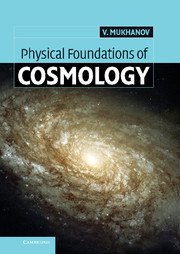Book contents
- Frontmatter
- Contents
- Foreword by Professor Andrei Linde
- Preface
- Acknowledgements
- Units and conventions
- Part I Homogeneous isotropic universe
- 1 Kinematics and dynamics of an expanding universe
- 2 Propagation of light and horizons
- 3 The hot universe
- 4 The very early universe
- 5 Inflation I: homogeneous limit
- Part II Inhomogeneous universe
- Bibliography
- Index
3 - The hot universe
from Part I - Homogeneous isotropic universe
Published online by Cambridge University Press: 05 September 2012
- Frontmatter
- Contents
- Foreword by Professor Andrei Linde
- Preface
- Acknowledgements
- Units and conventions
- Part I Homogeneous isotropic universe
- 1 Kinematics and dynamics of an expanding universe
- 2 Propagation of light and horizons
- 3 The hot universe
- 4 The very early universe
- 5 Inflation I: homogeneous limit
- Part II Inhomogeneous universe
- Bibliography
- Index
Summary
In the previous chapters we studied the geometrical properties of the universe. Now we turn to its thermal history. This history can be subdivided into several periods. Here we focus mainly on the period between neutrino decoupling and recombination. This period is characterized by a sequence of important departures from thermal and chemical equilibrium that shaped the present state of the universe.
We begin with an overview of the main thermal events and then turn to their detailed description. In particular, in this chapter we study the decoupling of neutrinos, primordial nucleosynthesis and recombination. Our considerations are based on well understood and tested laws of particle, nuclear and atomic physics below a few MeV and, as such, are not likely to be a rich source of future research. However, this is important background material which underlies the concept of the hot expanding universe.
The composition of the universe
According to the Friedmann equations, the expansion rate of the universe is determined by the energy density and equation of state of its constituents. The main components of the matter composition that played an important role at temperatures below a few MeV are primordial radiation, baryons, electrons, neutrinos, dark matter and dark energy.
Primordial radiation The cosmic microwave background (CMB) radiation has temperature Tγ0 ≃ 2.73 K. Its current energy density is about εγ0 ≃ 10−34 g cm−3 and constitutes only 10−5 of the total energy density.
- Type
- Chapter
- Information
- Physical Foundations of Cosmology , pp. 69 - 130Publisher: Cambridge University PressPrint publication year: 2005
- 1
- Cited by



